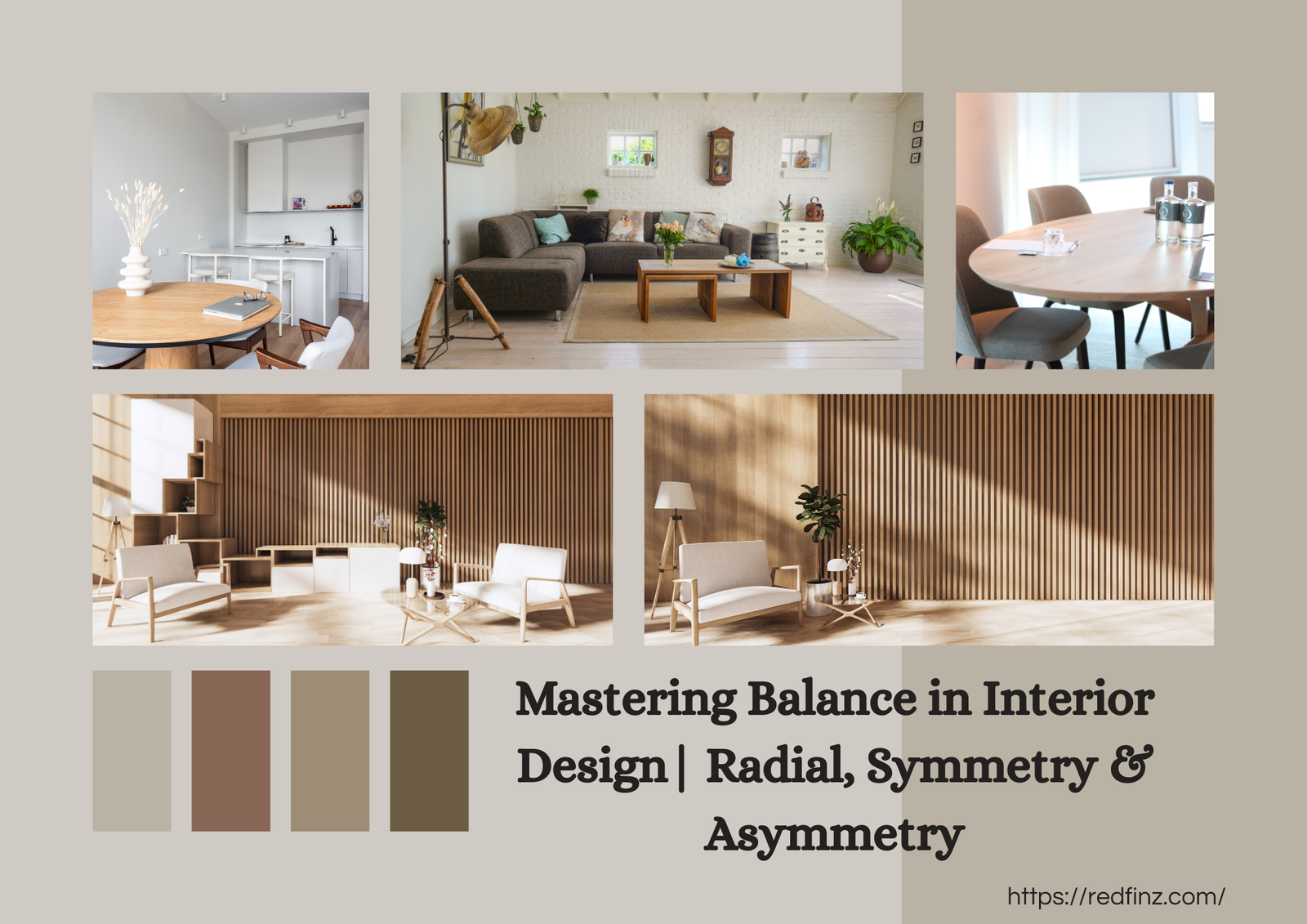Mastering Balance in Interior Design| Radial, Symmetry & Asymmetry
Interior design is about designing spaces that inspire comfort, beauty, harmony, and functionality. Another less-frequently used but powerful idea is radial balance. This style of design arranges elements in a circular pattern around a central focal point, resulting in symmetry, balance, natural flow, and a seamless flow that entices the viewer. It doesn’t matter if you’re creating an inviting cozy living room, a grand dining space, or a minimalist workspace, radial balance is a powerful tool to make interiors look visually stunning and balanced environments. Alongside Radial balance in interior design, understanding the difference between symmetrical and asymmetrical balance helps to create visual harmony and stability in both modern and traditional spaces.
What Is a Radial Balance Drawing?
Radial balance drawing illustrates how design elements extend outward from a central point in a circular or spiral arrangement. This ensures that lighting, furniture, lighting, textures, and décor balance space. Drawings like these are typically used in both interior and architectural design plans to create areas with a focal point, such as a chandelier, a round dining table, or a decorative rug. Through these sketches, designers can envision how equilibrium is achieved, and also how the eye flows naturally throughout the space.
What Is Radial Balance in Interior Design?
Radial balance in interior design requires the arrangement of elements around the central point that creates a circular pattern. Contrary to symmetrical balance that mirrors objects around a horizontal axis, or an asymmetrical balance, whereby the visual weight is distributed differently, the radial balance is focused on a centralized layout that is as if it is dynamic and calming. The design concept often draws its inspiration from natural patterns like the petals of flowers or spiral-shaped shells. This is organic harmony indoors, providing rooms with the feeling of classic elegance and scale.
Different Forms of Balance in Interior Design
In the realm of radial balance in interior design is a fundamental concept that can be found in three different types: symmetrical, asymmetrical, and Radial. radial. Symmetrical balance occurs when like or similar items are set on opposite sides of the central line. This method provides the formality, structure, and stability of an object, but it can also seem stale or static.
The asymmetrical approach, however, makes use of distinct elements with an equal visual weight to achieve harmony with no duplication. This style offers the possibility of creativity, modern appeal, as well as the ability to move; however, it requires careful positioning in order to prevent a messy appearance. The balance of the space is created by placing objects around a focus point, like an ambiance such like a chandelier, fireplace, or a round table. The method can be captivating visually and directs the viewer’s eye to the outside and ensuring harmony and unity, and flow across the room.
Principles of Radial Balance
The principle of Radial balance in interior design is based on creating a solid focal point that ensures proportional spacing in addition to giving a feeling of circular flow. A chandelier set in the middle of the dining room could serve as the center of the room, and furniture and Radial Balance in Interior Design extend outwards in harmony. Heavier objects are usually set closer to the center in order to create a solid foundation, while smaller elements are placed at the edges for an even distribution. Repetition of colors, textures, or patterns strengthens the overall cohesiveness of the design, turning ordinary interiors into harmonious and inviting environments.
Examples of Radial Balance in Design
Radial Balance in Interior Design can be seen throughout a range of design applications. The sunburst mirror with decorative accents provides a stunning focal point. The spiral staircase radiating out from a central axis provides both structural function as well as an aesthetic flow. A circular rug that is placed on the floor in the middle of the living room with furniture arranged all around brings the room together, highlighting the unity and proportion Radial Balance in Interior Design. These examples highlight how radial balance can bring both functionality and elegance into everyday interiors.
Creating Balance in Your Interiors
Finding Radial Balance in Interior Design is a careful use of symmetrical, asymmetrical, and radial methods. Symmetry is a good choice for classic interiors in which order and tradition are the main focus. Asymmetry is ideal for modern and contemporary spaces, providing the flexibility and creativity flexibility can be adapted to both environments, providing a smooth and beautiful structure that elevates the look of any area. Designers usually enhance the balance of an area by adding accents like mirrors, fireplaces, and artworks that draw attention to themselves, as well as mixing forms and textures in order to avoid monotony. Making sure to leave enough space is also important since it stops excessive crowding and permits everything to air. Repeated patterns and colors connect everything, making sure that the space is more harmonious than chaotic.
Benefits of Radial Balance in Interior Design
The advantages of Radial Balance aren’t limited to aesthetic appeal. It creates harmony, making interiors feel calm and inviting. It encourages natural motion that guides eye eye seamlessly across the area. Radial equilibrium is also extremely adaptable and can work well in smaller dining spaces as well as spacious living rooms redfinz. With the emphasis on a central focus, it improves the form and function and ensures that the room isn’t just beautiful, but also functional. When used in contemporary or conventional settings, radial harmony elevates spaces by adding elegance and awe.
Final Thoughts
Balance in interior design—whether symmetrical, asymmetrical, or radial—is the secret to creating interiors that feel cohesive, timeless, and elegant. By mastering these principles, you can transform any space into one that combines structure with creativity and harmony with functionality. Start by establishing a focal point, arranging furniture thoughtfully, repeating colors and textures for rhythm, and respecting the importance of negative space. With these techniques, your interiors will not only appear professionally designed but will also feel stable, inviting, and perfectly balanced.
Frequently Asked Questions (FAQs)
Q1: What is symmetry in interior design?
Symmetry is a design principle where elements are mirrored across an axis, creating stability and harmony.
Q2: What are the 3 types of balance in interior design?
The three types of balance are symmetrical balance, asymmetrical balance, and radial balance.
Q3: What is an example of symmetrical balance?
A pair of identical lamps placed on either side of a sofa is an example of symmetrical balance.
Q4: What is asymmetrical balance in home décor?
Asymmetrical balance uses different elements of equal visual weight to achieve harmony without mirroring.
Q5: How does radial balance work in interior design?
Radial balance arranges elements around a central focal point, creating a natural flow and circular harmony.
Q6: Why is negative space important in design?
Negative space prevents clutter, improves visual flow, and ensures objects have breathing room.






